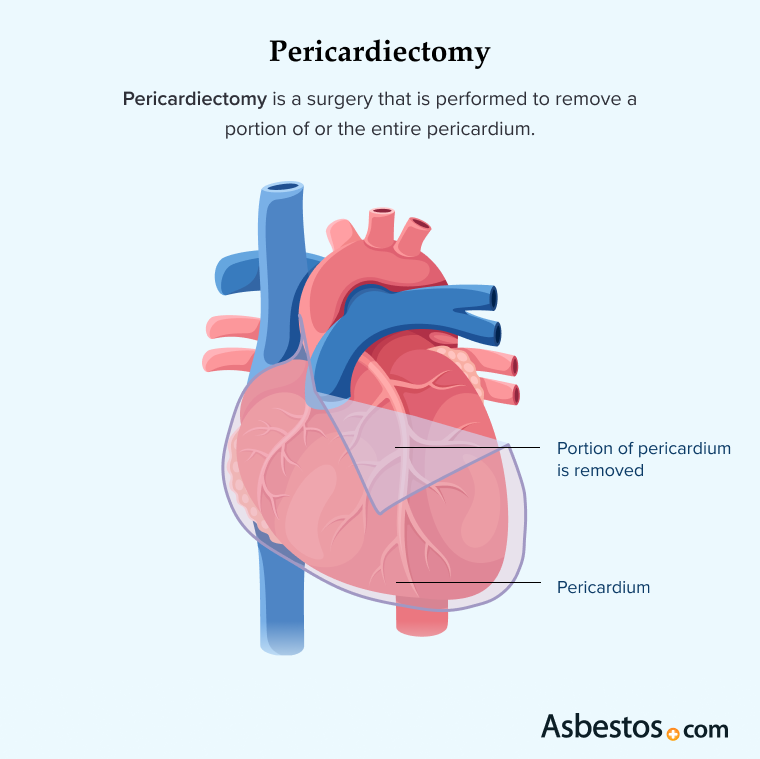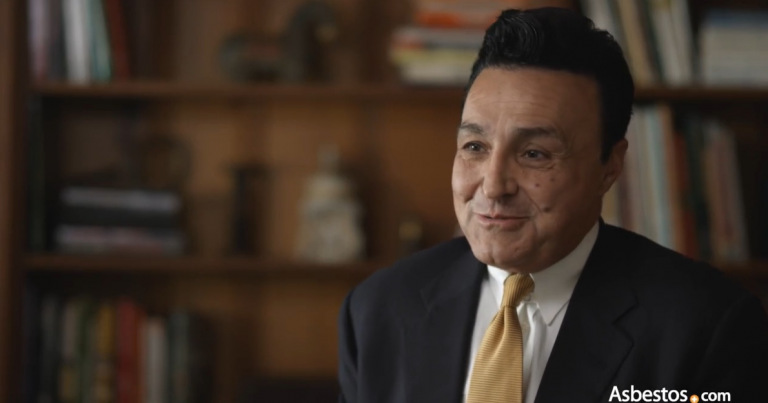Pericardiectomy
Pericardiectomy or pericardial window is a surgical procedure to treat diseases of the pericardium including pericardial mesothelioma. The surgery removes the outer covering of the heart sac known as the pericardium. It may extend life span or relieve symptoms.

What Is a Pericardiectomy?
A pericardiectomy is a surgical procedure also known as a pericardial window. It can help with difficulty breathing, chest pressure, heart palpitations and fatigue. The surgery can relieve pericarditis or inflammation of the pericardium. It also treats pericardial effusion or buildup of fluid in the pericardium.
Pericardial effusions often recur; therefore, opening the pericardial window or performing a pericardiectomy when pericardial fluid re-establishes should be considered with concurrent pericardial biopsy to determine the cause when the patient has symptoms suggestive of malignancy.
It’s important to treat these conditions early before they cause deadly complications. If pericardial effusion goes untreated, for example, it can put a significant amount of pressure on the heart. This can cause the heart to compress, which is called cardiac tamponade.
A partial pericardiectomy removes the affected portion of the heart lining. A total pericardiectomy removes as much of the heart lining as possible.
Surgical Consultation for Pericardiectomy
In some cases of primary malignant pericardial mesothelioma, a pericardiectomy may be indicated. Before the procedure, potentially eligible patients meet with the surgeon and his or her surgical team for a consultation.
These meetings are a great chance for you to find out more about the procedure, ask any questions that come up and share any worries. You can either do this in person or through video chat.
The surgical team will review your medical records, imaging scans and biopsy reports. This ensures you qualify for a pericardiectomy. They will discuss how you should prepare for surgery and the likely course of recovery.
How Is a Pericardiectomy Performed?
Before the surgery, a patient is put to sleep with general anesthesia. This procedure can take several hours. Depending on the scenario, the surgeon cuts the sternum along the vertical midline or makes an incision between the ribs. A mechanical spreader is used to allow access to the heart.
The pericardium then is carefully stripped off and removed. Along with it, the surgeon removes fluid in the area as well as tumor growth. Once this is completed, the surgeon closes the initial incision after inserting drainage tubes.
When patients ask about the pericardiectomy procedure, they ask about the benefits of such an invasive surgery. I share with them that for some it may prolong survival, and for some it may not prolong survival time, but may alleviate symptoms they may be experiencing related to the cancer.

Recovery After Surgery
This procedure usually requires a hospital stay of one or two weeks, but the length of time varies by patient. While in the hospital, the patient receives pain medication as needed, and recovery is monitored by a doctor or nurse. In the first few weeks after this type of mesothelioma surgery, some patients experience complications such as fever, redness, severe pain, swelling or drainage from the incision site. Such complications may result in a longer hospital stay.
A 2021 study presented at the Society of Thoracic Surgeons reported that the most common postoperative complications included prolonged ventilation in 26% of patients, atrial fibrillation in 21% of patients and pleural effusion in 16% of patients.

“After reading the guide, I felt more confident about what was ahead.” – Carla F., mesothelioma survivor
Get Your Free GuideEffects on Life Span
For people with mesothelioma, a pericardiectomy can help improve their prognosis or make them feel better. It might not affect how long they live if the cancer has already spread. For example, one person who had advanced stages of this disease got surgery to make them more comfortable. Even though it didn’t change the length of time they lived, they were able to survive for eight months after the operation.
For some people with a milder form of mesothelioma, this surgery could help them live longer. In one mesothelioma patient, a pericardiectomy was followed by a chemotherapy regimen. This combination put the cancer into remission and the patient remained free of cancer at a three-year follow-up.
According to a 2018 case report, another pericardial mesothelioma patient was alive at four years of follow-up thanks to a pericardiectomy. The 54-year-old woman experienced a recurrence that was successfully treated with another surgery.
Depending on the progression of a patient’s mesothelioma, pericardiectomy may improve prognosis or just alleviate symptoms.
Finding a Doctor
Though specialists in pleural and peritoneal mesothelioma are found throughout the United States, the extremely rare incidence of pericardial mesothelioma makes it difficult for a doctor to specialize in the disease. The annual incidence is approximately 1 in 40 million (0.0022 percent).
Heart surgeons, known as cardiac surgeons, are the physicians who perform pericardiectomies. Patients should ask how many of these procedures a surgeon has performed to gauge the experience level of the physician. Certain hospitals perform more of these surgeries than others, such as the Cleveland Clinic in Ohio and the Mayo Clinic in Rochester, Minn.
350
The number of cases of pericardial mesothelioma reported in the medical literature.
Source: Rare Tumors
Dr. Allan Klein is director of the Center for the Diagnosis and Treatment of Pericardial Diseases at Cleveland Clinic. Dr. Klein has also published several articles on pericardial disease and works with cardiac surgeons, such as Dr. A. Marc Gillinov and Dr. Douglas Johnston, who perform pericardiectomies at Cleveland Clinic.
Dr. Jae K. Oh is the director of cardiac imaging and the pericardial disease clinic at Mayo Clinic in Rochester. Dr. Oh has published several articles on pericardial disease and often serves as the overseeing cardiologist for patients who undergo pericardiectomies with cardiovascular surgeon Dr. Hartzell V. Schaff.
A diagnosis of pericardial mesothelioma can feel devastating to a person and their loved ones. If you or a loved one is diagnosed with this cancer, consider joining the monthly mesothelioma online support group to connect with other people facing mesothelioma cancer.
Recommended Reading





